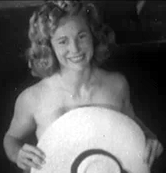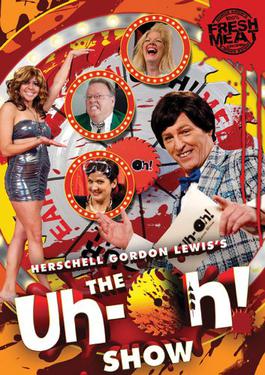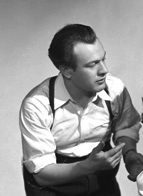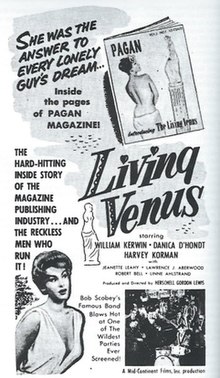
Blood Feast is a 1963 American splatter film. It was composed, shot, and directed by Herschell Gordon Lewis, written by Allison Louise Downe from an idea by Lewis and David F. Freidman, and stars Mal Arnold, William Kerwin, Connie Mason, and Lyn Bolton. The plot focuses on a psychopathic food caterer named Fuad Ramses (Arnold) who kills women so that he can include their body parts in his meals and perform sacrifices to his "Egyptian goddess" Ishtar.

Virginia Bell was a topless model and actress.

Herschell Gordon Lewis was an American filmmaker, best known for creating the "splatter" subgenre of horror films. He is often called the "Godfather of Gore", though his film career included works in a range of exploitation film genres including juvenile delinquent films, nudie-cuties, two children's films and at least one rural comedy. On Lewis' career, AllMovie wrote, "With his better-known gore films, Herschell Gordon Lewis was a pioneer, going further than anyone else dared, probing the depths of disgust and discomfort onscreen with more bad taste and imagination than anyone of his era."

Two Thousand Maniacs! is a 1964 American horror film written and directed by Herschell Gordon Lewis and starring 1963 Playboy Playmate Connie Mason. It follows a group of Northern tourists who are savagely tortured and murdered during a Confederate celebration of a small Southern community's centennial.
Connie Mason is an American model and actress who was Playboy magazine's Playmate of the Month for its June 1963 issue. Mason then acted in the gore movies pioneered by Herschell Gordon Lewis, Blood Feast and Two Thousand Maniacs! Her centerfold was photographed by Pompeo Posar. She was also a Playboy Bunny at the Chicago club.

Goldilocks and The Three Bares is a 1963 nudie-cutie film from the legendary exploitation team of Herschell Gordon Lewis and David F. Friedman. The plot of the film has nothing to do with the famous fable which inspired the title. it was billed as the "first nudist musical".

Hayley Elizabeth Atwell is a British and American actress. After appearing on various West End productions, Atwell gained popularity for her roles in period-drama films, appearing in the films Brideshead Revisited (2008), The Duchess (2008) and the miniseries The Pillars of the Earth (2010); for the latter two, she was nominated for a British Independent Film Award and a Golden Globe Award respectively.

Color Me Blood Red is a 1965 American splatter film written and directed by Herschell Gordon Lewis about a psychotic painter who murders people and uses their blood as paint. It is the third part of what the director's fans have dubbed "The Blood Trilogy," including Blood Feast (1963) and Two Thousand Maniacs! (1964).

The Wizard of Gore is a 1970 American splatter film directed by Herschell Gordon Lewis and starring Ray Sager, Judy Cler, and Wayne Ratay. The screenplay was written by Allen Kahn.

The Gore Gore Girls is a 1972 comedy horror splatter film directed by Herschell Gordon Lewis.

Suburban Roulette is a 1968 American drama film directed by Herschell Gordon Lewis and starring William Kerwin and Allison Louise Downe as characters who are involved in wife swapping to overcome the boredom of living in the suburbs.

A Taste of Blood is a 1967 American horror film, produced and directed by Herschell Gordon Lewis. It stars, among others, Bill Rogers and Elizabeth Wilkinson. The film was also known as The Secret of Dr. Alucard. Lewis considered it his masterpiece.

Scum of the Earth! is a 1963 American exploitation film directed by Herschell Gordon Lewis and produced by David F. Friedman. It is credited as being the first film in the "roughie" genre.

The Uh-Oh! Show is a 2009 comedy horror splatter film, written and directed by Herschell Gordon Lewis. The film revolves around a game show, The Uh-Oh! Show, where contestants play to win money by answering trivia questions, but appear to be dismembered for every wrong answer. Jill Porter, a reporter, suspects the gruesome attacks might not be fake.
Brooke McCarter was an American actor, producer, director, composer and musician. He is known for the role of Paul in the 1987 vampire horror comedy The Lost Boys.

Murray Korman was an American publicity photographer. He made his reputation in New York City as a "Hollywood style high key high gloss glamour" photographer whose clients ranged from showgirls to famous entertainers to members of "cafe society". Unlike other major theatrical portraitists of the time, he created his images in the camera, rather than manipulating them later at the printing stage. During the height of his fame, he was considered "the expert on beauty in his time".

The Doomsday Man is a fictional character appearing in American comic books published by Marvel Comics. Primarily an enemy of Carol Danvers, the character exists within Marvel's main shared universe, known as the Marvel Universe. Created by writer Stan Lee and artist John Buscema, the character first appeared in Silver Surfer #13.
William Kerwin was an American actor and filmmaker. He was most well known for his character roles in the films of Herschell Gordon Lewis.
Daughter of the Sun is a 1962 sexploitation comedy film directed by Herschell Gordon Lewis and produced by David F. Friedman. The film follows a young teacher who may lose her job after she is discovered to be a nudist. Lewis and Friedman produced the film after the success of the 1961 nudie cutie The Adventures of Lucky Pierre.
The Winter King is a British historical fiction television series based on Bernard Cornwell's trilogy of novels The Warlord Chronicles, starring Iain De Caestecker as Arthur Pendragon. The series premiered on MGM+ in the United States on 20 August 2023 and premiered on ITVX in the United Kingdom on 21 December 2023.















